Claussen Pickles are kosher dill pickles at their crunchiest, saltiest best! These homemade Claussen pickles taste like the commercial ones you find at the store, but better. And better yet, they’re ridiculously easy to make!
Whether you’re new to pickle making or a pickle veteran, you NEED to make these half sour pickles! And wonder of wonders, you don’t need to know how to can to make these super fresh, crunchy pickles! Claussen dill pickles are meant to be eaten fresh.
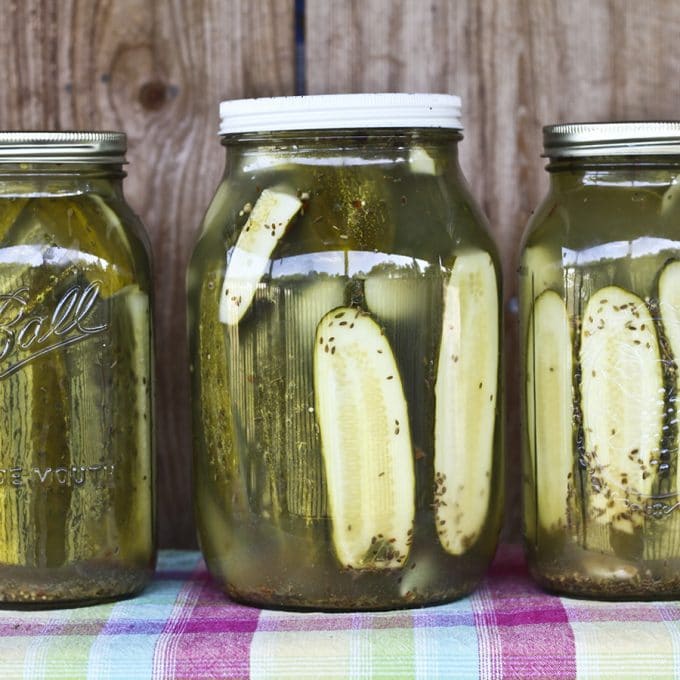
Homemade Claussen Knock-Off Pickles: Always crunchy and garlicky, this perfect homemade pickle recipe requires no special equipment, & no canning experience.
It’s common knowledge that I have a salty tooth rather than a sweet tooth. When the weather does what it has been doing lately (making us all do our best Shadrach, Meshach and Abednego impersonations) I can’t think of a single thing I find more refreshing than an icy-cold, salty, crunchy pickle.
It’s not just me, it’s my whole family: mother, sisters, brothers, cousins, aunts, grandparents, kids, husband… I married a man who loves pickles so much he eats the pickles and then drinks the juice from the jar.
I grew up eating my Grandma’s homemade dill pickles like the supply was endless and moved on to canning my own pickles as soon as I had a kitchen of my own. There’s just something about a homemade dill pickle that makes me happier than any pickled cucumber ever should.
My little sister, Jessamine, and I compare our homemade pickles from year to year the way some people compare wine vintages.
Dill Pickle Recipe
But there is one pickle that stands head-and-shoulders (were pickles to *have* heads and shoulders) above all others. I’m talking about the pickles you see here. That’s right: Homemade Claussen Dill Pickles.
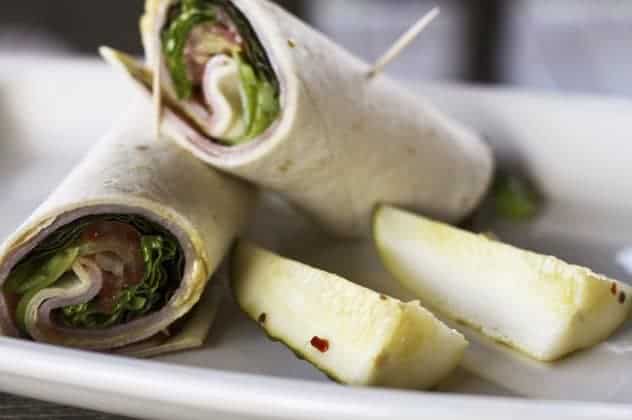
Recipe for Claussen Pickles
What do you need in order to make this recipe for Claussen Half Sour Pickles at home? Let’s get a quick list for both ingredients and equipment out of the way, shall we?
Equipment for Making Claussen Pickles at Home
- A Glass gallon jar or 4 glass quart jars or other food safe container with a tight fitting lid
- Measuring cup
- Chef’s knife or paring knife
Ingredients for Making Homemade Claussen Pickles Copycat
- Small to medium size pickling cucumbers (check your local farm stand or farmer’s market!)
- Apple Cider Vinegar (don’t fret- it doesn’t taste like apple cider and isn’t even a little sweet!) or white vinegar
- Kosher Salt
- Garlic
- Dill (either fresh or dill seed)
- Pickling spices (available here)
A quite note on your vinegar choice: I opt for apple cider vinegar because it’s a smoother vinegar than white vinegar. It does not impart any sweetness or apple taste to the pickles whatsoever.
If you can’t find it (pssst. It’s right next to white vinegar in even moderately stocked grocery stores) or don’t feel like buying it, you can most certainly substitute white vinegar. It’ll just taste a little sharper. (And technically store bought Claussen pickles have white vinegar, so you do you!)
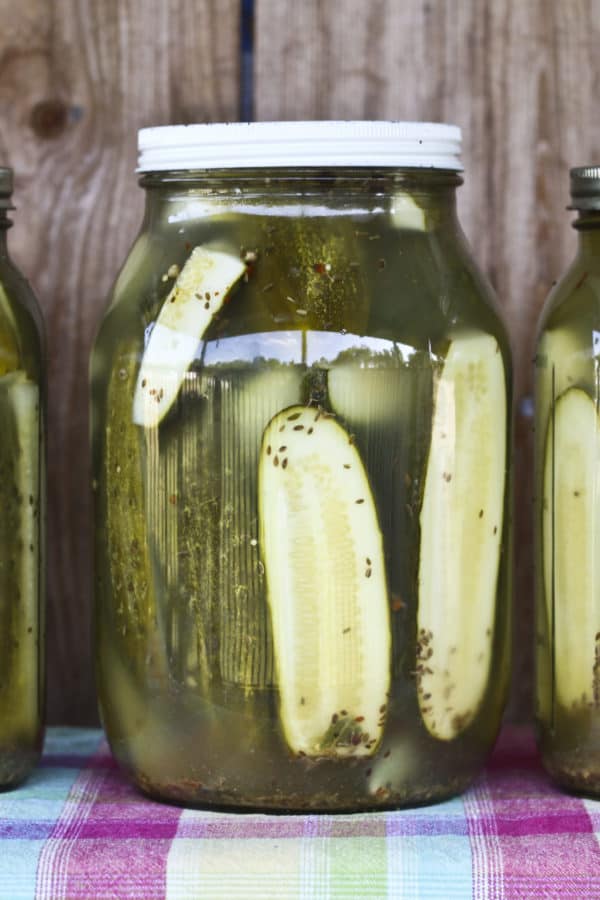
And ya’ll. These homemade half sour pickles are so easy to make it’s almost criminal.
The hardest part is the 2 to 4 day wait for them to be done. Truth be told, though, I’ve snacked on them the day after I made them and been a very happy camper.
Claussen Pickle Recipe
These are homemade refrigerated deli pickles, also known as Lithuanian half-sours, also known (in the commercial equivalent) as Claussen dill kosher pickles, also known as the best pickles ever known to mankind.
Here’s the thing. While I do love my other homemade pickles dearly (otherwise why would I continue canning ninety-something quarts year after year after year), these are by far my all-time favourites.
CRUNCH. That’s what you hear when you bite these. There is no flop, no squish, no soft pickles. These things almost bite back.
This also happens to be the perfect dill pickle recipe for beginning pickle makers. If you’re not into canning, these refrigerator pickles are a godsend. Even if you ARE canning obsessed, like yours truly, this Claussen pickle recipe should be in your pickle repertoire too.
Please note that this Claussen pickle recipe is not suitable for canning. The brine is fermented and not very acidic, which means it has far too high a PH to can safely. If you’re looking for a great canned dill pickle recipe, try this home canned garlic dill pickle recipe.
Refrigerator Pickles
Here’s where we get into the best part of this pickle recipe (aside from the crunch and flavor). You don’t have to cook anything to make these pickles; not one single thing. The brine is stirred together, the cucumbers are rinsed, trimmed and stuffed into a jar with garlic cloves and spices.
These half sour pickles are NOT CANNED. They are simply put into jars. Amen!
When it’s summer time and the idea of turning on the stove makes me want to crawl into an (air conditioned) hole, these pickles are a welcome treat. Not only is that cold crunchy refrigerator pickle waiting to cool me off at the end of the prep time, but I don’t have to heat up my kitchen by even one single degree to get there.
Remember that pickling isn’t just for cucumbers, either! Try out our Pickled Brussels Sprouts, Quick Pickled Red Onions, and famous Candied Jalapenos!
How to Make Pickles FAQ
Please, please, please give these a go even if you have never made a pickle before. There is nothing scary or intimidating here. Wash, slice, stuff, stir, pour, sit, wait.
- Trim 1/8-inch from the blossom end of each cucumber and slice them in half lengthwise or into quarters. The size you choose depends on how large your cucumbers are and how big you want the pickles to be when they’re done. This helps minimize the chances of soft pickles.
- In a gallon jar (or large, wide-mouth, food-safe container) layer the dill heads or seed, pickling spice or mustard seed, and garlic cloves and sliced cucumbers. If you’re dividing the cucumbers up between smaller containers, just divide the garlic and spices evenly between the containers, too.
- Stir your brine together in a separate container. You WILL have more brine than you have space for in the jars, but that’s why you pack the spices in the jars. Just store extra brine in a jar in the refrigerator and use it to top off your pickles if the brine starts evaporating.
- Pour the brine over the cucumbers, taking care to make sure all of them are fully submerged. If needed, place a plate or mug or other ziploc bagged can of beans on the cucumbers to weigh them down and keep them under the brine!
- Cover the jars lightly not tightly and leave out of direct sunlight on the counter for two to four days or until the pickles are picklicious.
- If your kitchen is pretty hot or humid, you can stash them directly in the refrigerator. They’ll just take a couple of days longer to get fabulous. Your patience will be rewarded.
On the plus side, the wait is only two to four days which is significantly less than the six week wait of the canned pickles. Besides, as I said, there is the crunch factor
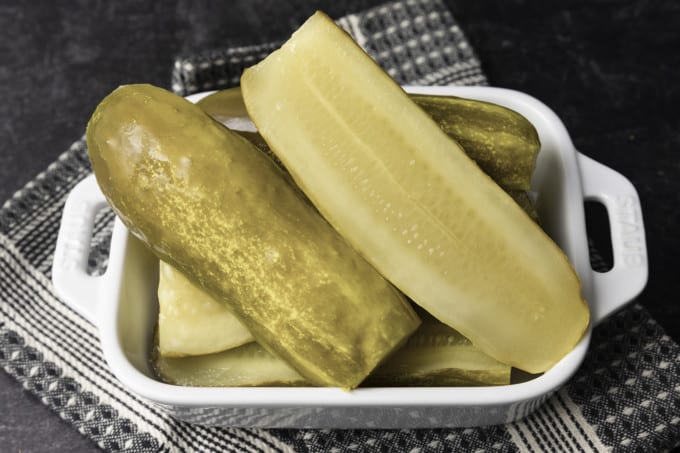
Troubleshooting Your Homemade Claussen Pickles
These pickles are easy peasy to make, but there still may be a couple of things that pop up from time to time that make you go “Hmmm…” In no particular order, here are some of the most commonly asked questions about them and some answers!
- Why is my pickle brine cloudy? Okay, I lied. This is the most common question and that’s because the brine becomes cloudy naturally as a consequence of fermentation (which is what’s happening here.) No worries.
It’s all natural. This half sour pickle recipe (more on this to come) is a fermented pickle recipe and that just happens.
Another possible cause of intense cloudiness or discolouration in your brine is using table salt. The iodine in table salt can also give off flavours to your pickles, so it’s best to stick with kosher salt or pickling salt for these bad boys! - Is the scum, foam, or film on top of my pickle brine dangerous? It’s that pesky (and delicious) fermentation again! This is another thing you don’t have to worry about.
Just scrape it off with a spoon, discard, and top off with a little of that extra brine you whipped up. (See the recipe card for details.) But do remove the scum or it could cause your pickles to go bad. - My pickles went soft! How do I prevent this? This particular tragedy could have two causes.
First, you may have failed to remove enough of the blossom end of the cucumber. There is a naturally occurring enzyme in the blossom end of cucumbers that causes pickles to break down and become soft if it is not removed. Next time, just slice more off.
Second, you may have started with less than spectacularly fresh cucumbers. An older cucumber has had longer for the aforementioned enzyme to kick in, and it has already started its work.
The best solution for this issue is to use cucumbers that have either been picked fresh that day or have been refrigerated steadily since very shortly after being picked a couple of days previously. - Why did my pickles go bad? See that second reason in the “why did my pickles go soft” bullet point? That’s one culprit.
Other potential causes of spoiled pickles are using unwashed cucumbers or fresh dill, old or decayed garlic, bad spices, lower-than-5%-acidity-vinegar, failing to remove the scum from the brine or to keep the pickles submerged in the brine, or storing your pickles in warmer conditions. When in doubt, stash them in the refrigerator! - Why is there mold on my pickles? First, you have my condolences. Second, it’s because your pickles didn’t stay submerged in the brine. That brine has enough salt and acid to prevent mold growth if the cucumbers stay under the surface.
If you’re having trouble finding something that fits in the jar to keep this from happening, try popping a can or two of tomato paste or canned beans in a zipper top bag and gently inserting that into the jar. It should weigh it down enough to do the job. - Should I worry about the white sediment in my jar? This is another one in the “don’t sweat it” category. There are two potential reasons and both are completely harmless.
It’s either a natural consequence of the fermentation or anti-caking agents in the salt. Neither harms the pickles or effects the flavour, so don’t worry! - Why is my garlic blue/green/purple? As long you inspect the garlic before it goes into your jars and it is fresh as a daisy, you have nothing to worry about. It could be the type of salt you used or it could be the variety of garlic. Some types of garlic have a natural propensity to change pretty colours in vinegar.
It also may mean that your pickles were exposed to light. When garlic is exposed to light, it starts producing chlorophyll which is green. It also may indicate that your garlic is more mature.
In that case it is caused by sulfur compounds that naturally occur in more mature garlic reacting with minute traces of copper in the vinegar., but as long as there are no other signs of spoilage (soft or squishy texture, funky smell, discoloured spots), you’re good to go.
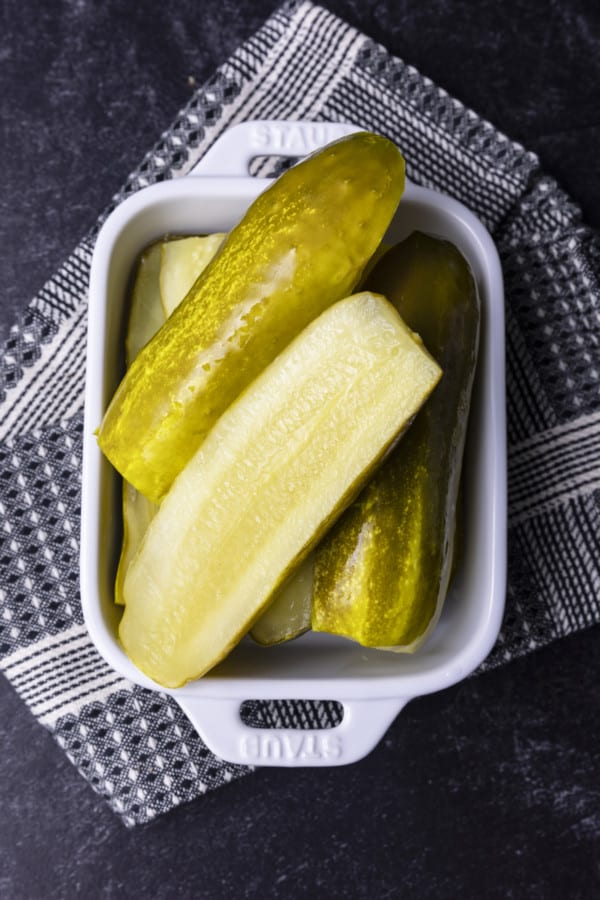
IMPORTANT NOTE: Because there is so much diversity in temperature, humidity, age of cucumbers, etc… involved in this recipe, please check your half sour pickles starting at 24 hours for doneness. If the pickles smell/taste pickley, move them to the refrigerator. Do not keep them on the counter longer than 4 days.
ANOTHER IMPORTANT NOTE: These pickles are not suitable for canning. They’re simply not acidic enough to can safely, and that is in addition to the fact that you’d ruin that perfectly crisp texture by introducing heat to the party.
What can I serve with these Homemade Claussen Knock-Off Pickles?
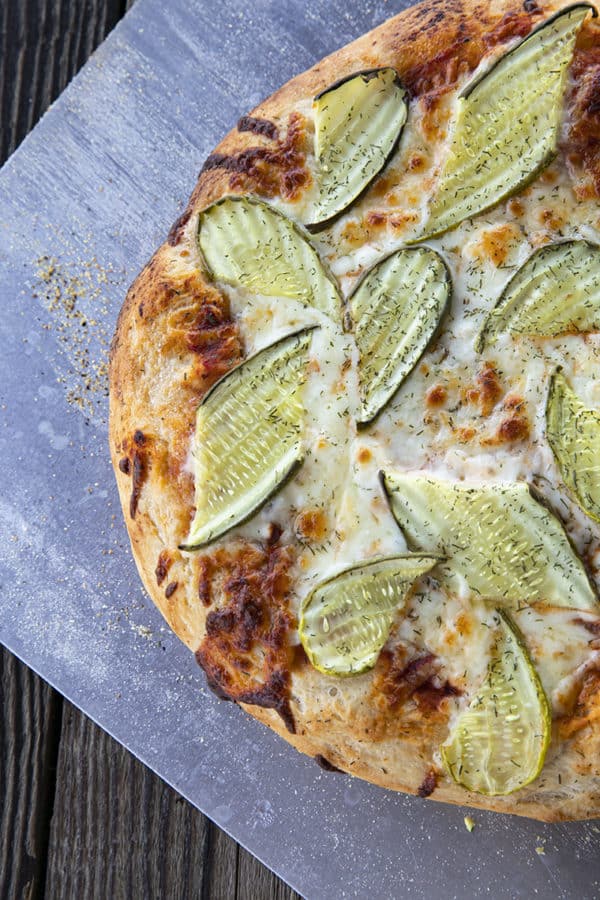
Start out by trying your half sour pickles in this Pickle de Gallo, Dill Pickle Dip, Dill Pickle Egg Salad, or Bagel Burgers with Dill Pickle Cream Cheese.
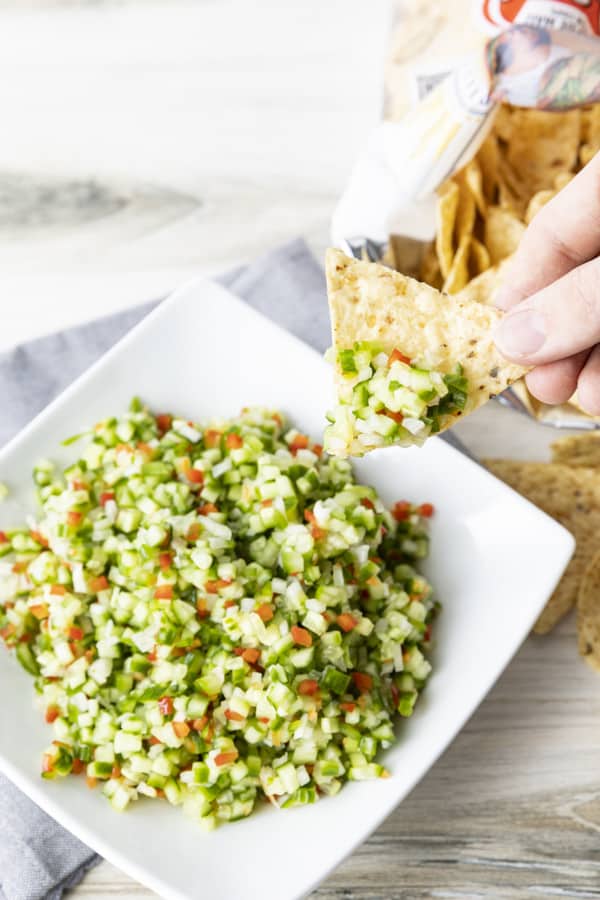
Even better, serve them on our Cheeseburger Salad or Pickle Pizza.
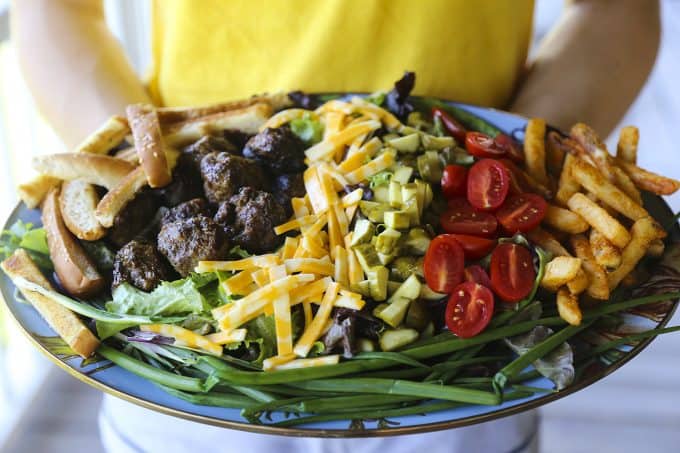
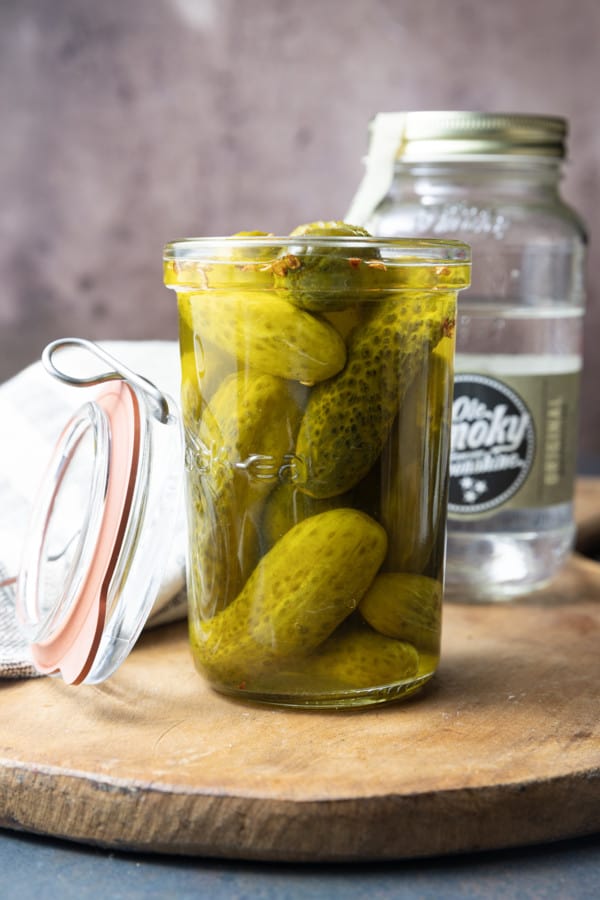
You can even take extra pickles (like that’s a thing!) and make these divine Moonshine Pickles. You’ve never had a better Bloody Mary than one made with homemade Moonshine Pickles!
Half Sour Pickle Recipe
What makes Claussen PIckles different from canned pickles? Claussen pickles, whether homemade or store bought, are a half sour pickle recipe.
That means they’re fermented instead of heat processed. That’s what gives them such great texture.
This half sour pickle recipe yields pickles that are crunchy to the point of making noise when you bite them, cold, and seriously garlicky. Canned, shelf-stable pickles can be chilled, maintain some crunch, and be as garlicky as you want them to be, but they are never, ever going to be the same thing because of science.
When you heat process a jar of pickles you are, in actuality, cooking it and a cooked pickle just plain can’t be as crunchy as an un-cooked half sour pickle recipe.
These homemade pickles keep well in the fridge for about six months, as long as they remain submerged in the brine. In our house, they never last that long because, as the saying goes, “A pickle a day keeps sad times away.”
They say that right? Someone must. If not, I’m going to start. It’s true, after all.
Claussen Pickles
Wash cucumbers but do not scrub them.
Trim 1/8-inch to 1/4-inch from the blossom end of each cucumber and slice in half lengthwise or into quarters, depending on how large your cucumbers are and how big you want them to be when they’re done.
Layer the dill heads or seed, garlic cloves, pickling spices and sliced cucumbers in a gallon jar (or large, wide-mouth, food-safe container). You can evenly divide the dill, garlic cloves, pickling spices, and cucumbers between several smaller jars if needed.
In a separate pitcher or bowl, stir together the remaining ingredients until the salt is dissolved.
Pour the brine over the cucumbers, taking care to make sure all of them are fully submerged. If needed, place a plate or mug or other non-reactive heavy item on the cucumbers to weigh them down and keep them under the brine!
Cover lightly with a lid just perched on top or secure a piece of cheesecloth over the jar with a rubber band to keep fruit flies away. Store any extra brine in a covered jar or pitcher in the refrigerator and use it to top off the brine if it starts to evaporate and expose the pickles to the air.
Leave out of direct sunlight on the counter for at least 24 hours, but up to 4 days, or until the cucumbers taste like pickles throughout.
Fix your lid onto your jar or container and chill thoroughly. These can be stored in the refrigerator for up to six months provided you keep them covered with brine.
NOTE: If at any point in the proceedings “fuzz” or “foam” develops on top of the brine, use a spoon to remove it. If there is “fuzz” attached to any of the cucumbers, remove the ones affected and be sure the others are still fully submerged.
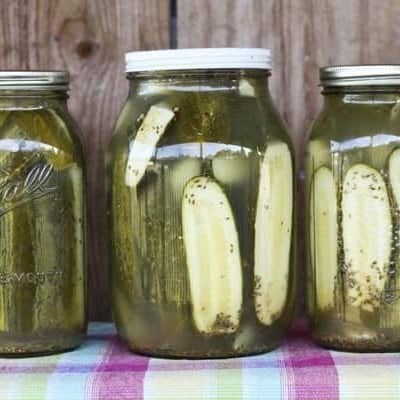
Homemade Claussen Knock-Off Pickles
Equipment
- 1 gallon jar or 4 quart jars or a large, food-safe container with a tight fitting lid
- 1 liquid measuring cup
- 1 large mixing bowl or pitcher
Ingredients
- 35 to 40 small to medium pickling cucumbers
- 1 gallon cold water
- 1 cup apple cider vinegar, preferably raw or white distilled vinegar
- 2/3 cup coarse canning or kosher salt Do NOT fine or use iodized salt!
- 4 cloves garlic or more to taste
- 4 heads fresh dill or 4 tablespoons dried dill seed not weed!
- 2 tablespoons mixed pickling spices
Instructions
- Wash cucumbers but do not scrub them.
- Trim 1/8-inch from the blossom end of each cucumber and slice in half lengthwise or into quarters, depending on how large your cucumbers are and how big you want them to be when they’re done.
- In a gallon jar (or large, wide-mouth, food-safe container) layer the dill heads or seed, garlic cloves, pickling spices and sliced cucumbers.
- In a separate pitcher or bowl, stir together the remaining ingredients until the salt is dissolved.
- Pour the brine over the cucumbers, taking care to make sure all of them are fully submerged. If needed, place a plate or mug or other non-reactive heavy item on the cucumbers to weigh them down and keep them under the brine!
- Cover lightly with a lid just perched on top or secure a piece of cheesecloth over the jar with a rubber band to keep fruit flies away.
- Leave out of direct sunlight on the counter for two to four days*, or until the cucumbers taste like pickles throughout.
- Fix your lid onto your jar or container and chill. These can be stored in the refrigerator for up to six months provided you keep them covered with brine.
- *If at any point in the proceedings “fuzz” or “foam” develops on top of the brine, use a spoon to remove it. If there is “fuzz” attached to any of the cucumbers, remove the ones affected and be sure the others are still fully submerged.
Notes
Nutrition
Nutritional information is an estimate and provided to you as a courtesy. You should calculate the nutritional information with the actual ingredients used in your recipe using your preferred nutrition calculator.
did you make this recipe?
Make sure to tag @foodiewithfam on Instagram and #hashtag it #foodiewithfamily so I can check it out!
Originally published July 22, 2011. Updated with FAQs and Troubleshooting and reposted August 2022.
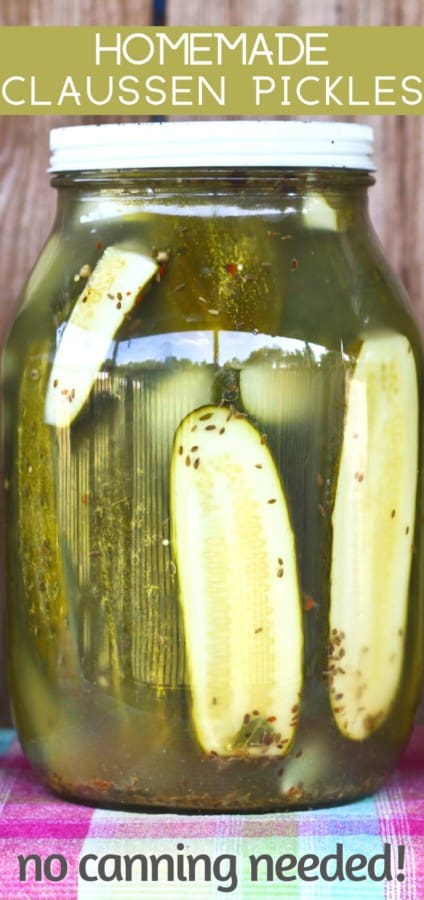
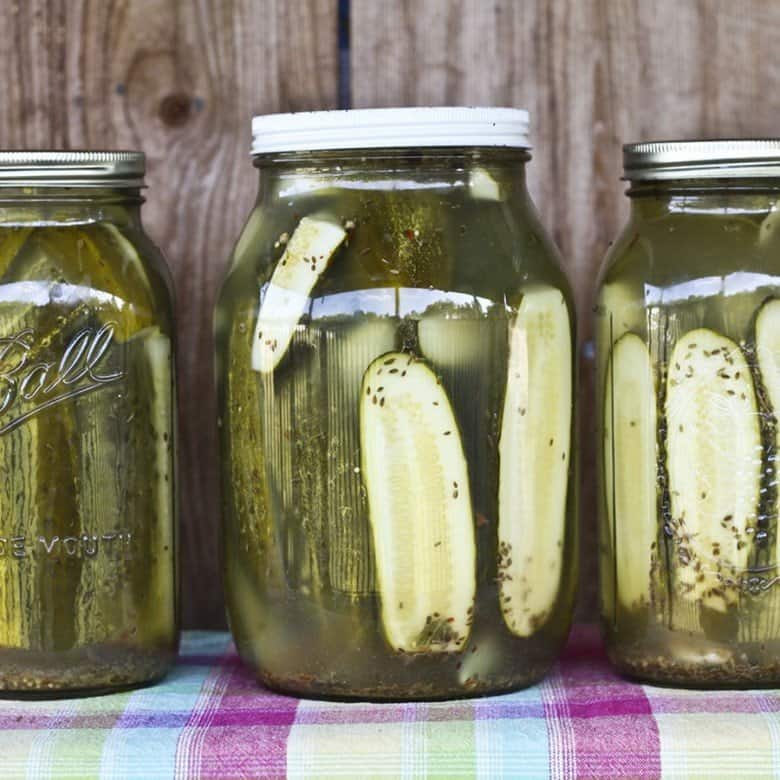
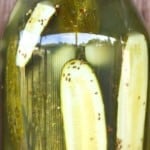



Reader's Thoughts...
David Emery says
There seems to be a mistake in this recipe. It calls for a one gallon jar to be filled with a gallon of water and a cup of vinegar as well as the cucumbers etc. The gallon of water alone will fill the gallon jar leaving no room for the cucumbers or any of the other ingredients.
Rebecca says
Hi David- It’s not a mistake. There is no possible way you’ll fit all that brine in, but having extra brine to top off the jar if any evaporates is not a problem. 🙂 I’d rather have too much brine than too little.
Patricia Callahan says
Why is the ratio of water (1 gal) to cider vinegar (1 c) so high? All the other refrigerator pickling recipes I use about 50/50, water to acid.
Rebecca says
Well, it’s that high because it works really well and creates delicious pickles here. 🙂 I can’t explain why other people did what they did, but I love the pickles we get from this ratio.
Greg says
I will definitely try these. My local stores never have the slices for sandwiches. Although, I don’t know where to buy pickling cokes.
Rebecca says
Hi Greg- A local farmers market is always a good bet! Sometimes road-side farm stands have them, too!
Judy Brick says
I tried to find out what raw cider vinegar is and only got Google results about raw APPLE cider vinegar. I don’t think you used that – isn’t apple cider vinegar golden in color? Your pickles look like they are in white vinegar. This is an important distinction. Help!
Rebecca says
Hi Judy- I did indeed use raw apple cider vinegar. Bragg’s is the brand I prefer. And there’s very little of the vinegar in the actual pickles, so it ends up being relatively clear. 🙂
Kel X says
You know you have an interesting recipe when you have 500 million pages of comments going back 10 years! If you have an ability to clean that up, you may want to, because It’s actually so much that it’s hard to view the page without it crashing. Just wanted to add one thing: Claussen specifically says on their hard that their pickles are chilled from start to finish, so the part about leaving them unrefrigerated for a couple days doesn’t seem right. Also, it would be helpful if you would post an alternate version for smaller batches, and give us an idea of what is in these pickling spices, which many people simply do not have. That aside, this looks really great, and since the pandemic has resulted in a glass jar shortage meaning Claussen pickles have been removed from a lot of stores, this is a popular time for homemade pickles.
Rebecca says
Hi Kel- I like to have those comments in place because there is a lot of good discussion about what has and has not worked for other folks. I am aware Claussen has some differences in production, but these are darned good pickles and I stand by them. Well, I actually sit by them and eat them, but I digress. As for pickling spices, I actually did talk about that in one of the bajillion comments, but I won’t make you scroll back. If you hit CTRL F or Command F (depending on whether you use pc or mac) you should be able to tap through the comments mentioning pickling spices. In the meantime, I’ll post a quickie version of my preferred blend in the next week. 🙂
Nathan Apatow says
The jar I purchases on April 29th was much too salty. I have the number on the lid if you need it.
Rebecca says
Hi Nathan, thanks, but I can’t help you with quality control at Claussen. I’d advise you to contact them.
Barbara snyder says
One of the best and easiest pickles recipes ever. I also make a brass kettle pickle a long time family recipe and bread & butter pickles too. We grow our own pickles
Rebecca says
Those brass kettle pickles sound intriguing, Barbara! I’d love to hear more about them.
Greg Hubanks says
Hello Rebecca: Have you ever added pickle crisp and/or would you recommend adding it to the recipe? If yes, at what point in the process would you recommend adding it?
Many thanks!
Greg
Rebecca says
Hi Greg! I have never tried pickle crisp with these because they stay WICKED crunchy in the fermentation process… If you give it a go, let me know if you try it!
Nora says
Thanks for this great recipe. However: PLEASE CORRECT TO OMIT REFERENCES TO KOSHER SALT. You can’t use kosher salt for pickling; it will turn cloudy. You must use pickling salt only.
Rebecca says
Hi Nora- Actually, I use kosher salt in this recipe, so I’ll not be omitting the references. It may turn cloudy, but it doesn’t effect the flavour like iodized salt would, so I’m fine with it. I’m glad you like the recipe.
Nora says
Hi Rebecca,
I should clarify that kosher salt is ok IF it doesn’t have the anti-caking additive that some kosher salt has. Pickling salt has no additives so it’s always good. Personally I think it’s easier just to use something I know will never cause cloudy brine. Also, while I guess that the offensiveness of a cloudy brine is a matter of personal preference, I think that a nice clear brine is a bit more appetizing. Pickling salt is not an exotic ingredient and is generally available at any grocery store and also any hardware store.
davey says
I’ve made these a bunch of times using kosher salt and they come out great. A cloudy brine does not bother me.
Jeff says
What are pickling spices
Rebecca says
Hi Jeff- It’s a blend that you can purchase in the herbs and spices sections of most grocery stores. It’s very widely available. 🙂
Dennis Golden says
One more inquiry from Dennis Golden . Do I use unfiltered cider vinegar from health food store or does plain generic cider vinegar accomplish the same thing . I am an internet illiterate . Dont know if I will ever see your answers . But I will look up this site again . Please no offers from salesmen .
Dennis Golden says
I love Clausen pickles better than All others . When I empty the jar, I have all brine and spices left . Can I reuse that to make more of my own ? Or is it too used up? This is personal . Please don’t give my name or email to Any Merchant or?
Rebecca says
Hey Dennis- No worries- I deal in food, not selling email addresses 🙂 I would not re-use the Claussen brine that way. I’d personally drink it because YUM or use it in recipes like potato, egg, or chicken salad.
And to answer your second question, I like to use the unfiltered raw cider vinegar with the mother in it (Bragg’s is just one brand that’s readily available) because it helps kickstart the fermentation a bit.
Cooper says
This recipe is garbage. I followed it exactly and they taste nothing like claussen pickles. I make pickles all the time and also eat claussen pickles everyday. DO NOT WASTE MONEY ON MAKING THESE!!
Rebecca says
So, Cooper. I have to ask. Did you use pickling cucumbers or did you use regular grocery store cucumbers? Because that will make a huuuuuge difference in the outcome here.
Ursula Mcintosh says
Ok I’m doing it 😊
Rebecca says
Have fun!
Rick says
What do pickling spices consist of???
Rebecca says
Hi Rick- I’m not sure why you rated the recipe 1 star with a question. Pickling spices are a ready-made blend (most often) sold in most grocery stores. The one I buy has mustard seed, black peppercorns, allspice berries, coriander seeds, ginger, bay leaf, red pepper flakes, and in some cases, whole cloves and crumbled cinnamon sticks.
Carol says
Just found your site and love it! I have already made the Claussen knockoff pickles and was wondering if you can reuse the brine? It’s clear, no foam or fur and it seems like such a waste…?
Rebecca says
Hi Carol! I’d use it to plunk other veggies in, but I don’t think I’d actually re-go for the pickles!
Jess says
I plan to use this recipe to make pickle popsicles! Claussen pickles are my favorite and I’ve been buying these pickle popsicles online for months now but it’s become expensive, so now I plan on making my own! The popsicles are so addicting I’ve been eat at least 2 a day for months now and my stomach problems have gone away and I feel more hydrated. I’m glad I came across this recipe. 🙂
Rebecca says
I’m so glad you did, too, Jess! Welcome! 🙂
Jennifer says
Way to salty otherwise good. I suggest cutting salt to 3/4 Tablespoons per quart.
Rebecca says
It depends on the type of salt you use, Jennifer! Morton’s Kosher salt is my salt of choice and this recipe is geared toward using it.
Diane says
Loved this recipe-I haven’t found anyone who didn’t like them! Thanks!
Rebecca says
I’m so glad you love them, Diane! Thanks for taking the time to rate the recipe and let me know you love it.
Lynda H says
When you think they’re as good as claussen you’ll find them even better the next day. I would choose these pickles over store bought claussen every time, they’re fantastic! Thank you for sharing your recipe and tips.
Rebecca says
Thank you so much for taking the time to rate the recipe and let me know you love them, Lynda! You made my day!